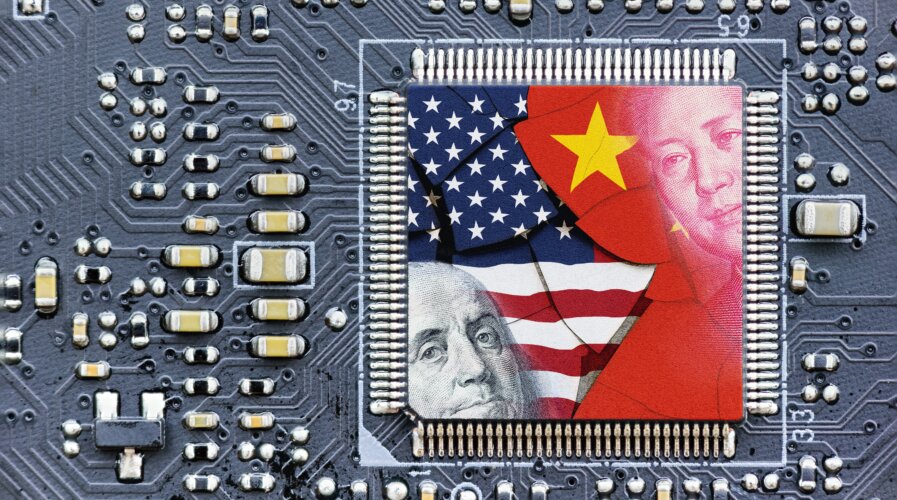
Semiconductor: Chip nationalism is a ‘blessing,’ SEMI CEO saysSource: Shutterstock
Semiconductor: Chip nationalism is a ‘blessing,’ SEMI CEO says
- SEMI President and CEO Ajit Manocha reckons that multiple hubs worldwide would encourage the growth of the chip industry, which is expected to reach US$1 trillion in revenue by 2030.
- While chip nationalism is becoming commonplace, Ajit believes it is not necessarily bad but would undoubtedly change the semiconductor landscape.
- He also feels the chip shortage is close to over as demand has softened while companies add more capacity.
The semiconductor industry represents the world’s most essential and coveted technology. Semiconductors comprise the “brains” for everything, from mobile phones, game consoles, and cars to AI, machine learning, and the Internet of Things (IoT). The pandemic even highlighted how, as a vital component in modern products, chips are essential for economic and national security.
Then begin the quest for self-sufficiency, which comes with its risks. But to Ajit Manocha, President and CEO of SEMI, ‘chip nationalization‘ should not be frowned upon. “You call it nationalization; I call it chip supremacy. Countries have learned their lesson that they need to have more self-reliance on semiconductors in their country,” he told Tech Wire Asia (TWA) on the sidelines of recently-concluded SEMICON Southeast Asia in Penang, Malaysia.
Manocha was asked how “chip nationalization” by governments worldwide impacts the market. For context, the pandemic has led to the recognition by major global powers that semiconductor manufacturing is increasingly a strategic imperative. “So that’s why it has become a national strategic agenda for many countries. And I think, at the same time, I call it a blessing,” Manocha said.
Chip nationalization is when countries with chip capacities try to ensure that they tie up supplies and stocks for their requirements first. Simply put, it is governments’ attempt to onshore semiconductor supply chains entirely or build a semiconductor supply chain of politically allied countries.
“Because if the industry is going to grow to US$1 trillion, it’s okay to have more multiple hubs and create more redundancies in the supply chain,” he added. “So if more semiconductor hubs are built in more countries, that’s probably a good thing as that will make us less dependent on just a few hubs.”
Manocha believes the move to create multiple hubs will lead to a more distributed supply chain. “So that’s why I’m all for growth in Southeast Asia,” he told TWA. As SEMI–the global industry association that unites electronics manufacturing and design supply chain–has reiterated since the pandemic, the semiconductor sector worldwide is forecasted to reach a revenue of US$1 trillion by the end of this decade.
As of 2022, the industry’s revenue was slightly below US$600 billion. “Maybe it’ll be in 2031 or 2032, but not 2040. It’ll be sooner than later because the demand for semiconductors is unprecedented. AI is also fueling the growth, which will need more hardware. AI will broaden the scope of the semiconductor applications on chips beyond anybody’s imagination,” he noted.
He even noted that the rise of quantum computing, which Manocha said “is just around the block,” will fuel the industry further. “So I don’t see any reason to think the semiconductor industry will have any steep down cycle. Yes, we’ll have some corrections here and there, but I think we’ll be witnessing steeper up cycles and probably very few shallow down cycles,” he emphasized.
The US-China semiconductor rivalry and its impact
The US enactment of the CHIPS and Science Act signals a new era in international trade and geopolitics. The statute, passed by Congress last year but yet to be enacted, is aimed at countering and containing China’s techno-nationalist ambitions and preserving the US lead in key tech industries.
“Our philosophy is evident that for all policy matters, we bring the industry voice to the policymakers worldwide and help them understand what will create a barrier for the industry. Our motto is a pro-global supply chain, pro-industry, pro multilateral policies. As for the tensions like the US-China ones, those are creating a change in the semiconductor industry landscape. But more than the landscape change,” Manocha concluded.
READ MORE
- 3 Steps to Successfully Automate Copilot for Microsoft 365 Implementation
- Trustworthy AI – the Promise of Enterprise-Friendly Generative Machine Learning with Dell and NVIDIA
- Strategies for Democratizing GenAI
- The criticality of endpoint management in cybersecurity and operations
- Ethical AI: The renewed importance of safeguarding data and customer privacy in Generative AI applications


